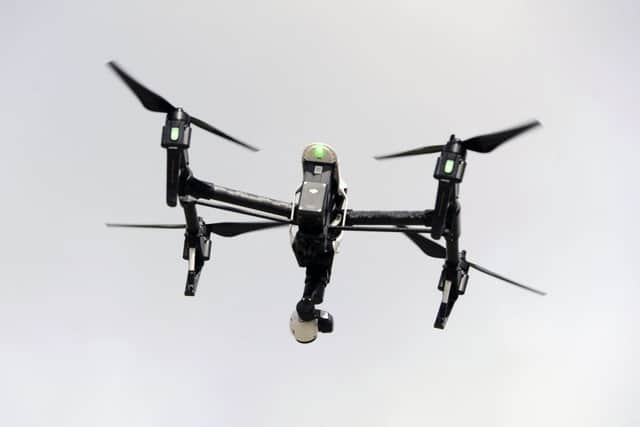Jail drone drug smuggler left home co-ordinates on device


John Grant lost control of the aircraft and it crashed with its load of drugs and mobile phones in a residential garden in Edinburgh, well short of its intended prison touchdown.
The High Court in Edinburgh heard how the device also contained footage on its camera of Grant adjusting settings on the drone and with GPS co-ordinates of his home address.
Advertisement
Hide AdAdvertisement
Hide AdThe drone was found by a woman in the Redhall area of Edinburgh who noticed a lot of string strewn around her back garden.
When she began to gather it up a black sock attached to the string fell from the roof of her garden hut. She then found it was attached to a drone wedged between her hut and fence.
She cut open the sock and found three mobile phones, two chargers and a haul of heroin and diazepam.
The court heard that the heroin was worth £11,000 but its value would soar if it had successfully been delivered into prison.
Advertisement
Hide AdAdvertisement
Hide AdAfter Grant, 47, was identified from film recovered from the drone and a search of his home found a further half kilo of heroin worth £48,000.
Advocate depute Jim Keegan said the heroin recovered was valued at £59,000 but more money could have been made out of it because of the premium payable in jail and its high purity.
In what is believed to be the first conviction of its kind, Grant, formerly of Loganlea Terrace, in Edinburgh, admitted being concerned in the supply of heroin between November 5 and 18 last year.
He also admitted two breaches of Scottish prison legislation by attempting to fly the Class A drug and mobile phones into Saughton jail in Edinburgh on November 5.
Advertisement
Hide AdAdvertisement
Hide AdHe also pled guilty to culpably and recklessly piloting “an unmanned aircraft system” at night with its aviation lights taped making it invisible to other aircraft to the danger of the public and other aircraft. Grant was on bail at the time of the offences.
A judge told Grant: “You have pled guilty to a series of serious charges.”
John Morris QC said his crimes were aggravated by attempting to introduce “drugs and other contraband into one of Her Majesty’s prisons”.
Mr Morris said that the flying of the drone at night was “reckless conduct in the extreme which could have had catastrophic consequences”.
Advertisement
Hide AdAdvertisement
Hide AdThe judge said Grant would have faced a prison term of eight years, but his sentence would be reduced to five years and four months following early guilty pleas.
Grant, a former mechanic, was previously jailed for 44 months for a drug trafficking offence.
Advocate depute Jim Keegan said that after the downed drone was recovered a memory card was found containing images and footage and GPS information.
The prosecutor said: “Footage from the early hours of November 4 showed the accused seated in his living room and operating a remote controller and an electronic tablet to adjust the drone’s settings.”
Advertisement
Hide AdAdvertisement
Hide AdFilm from the drone making flights over the Loganlea and Saughton areas of the city on November 4 and 5 was also found.
Some of the nighttime flight footage was shown to the court with lights from Saughton prison seen far below. During the showing the judge commented: “It seems to be going away from Saughton.”
Mr Keegan said that during the search of Grant’s home police also discovered a metal mould for pressing heroin and an iPad used to control the drone. A box for the drone and a set of instructions were also recovered.
During the search at the house a woman turned up who was aware of the bid to use the drone to drop drugs and phones into the prison.
Advertisement
Hide AdAdvertisement
Hide AdMr Keegan said she “was able to tell the police about the plan that had gone wrong and that the accused was angry and concerned about having lost his drone and its payload”.
The prosecutor said: “Footage from CCTV in the area showed the accused Ford Transit being driven in and around the Loganlea area at times consistent with the launching of the drone in the early hours of November 5.”
He added that the DJI Phantom 4 drone was launched from waste ground between Scallywags nursery and Longstone Hearts club in the city’s Longstone Road.
Mr Keegan told the court: “It is important to be clear that the DJI Phantom is regarded by the Civil Aviation Authority as an aircraft and not a toy. It falls into the category of a small unmanned surveillance aircraft, due to the data collection capability.”
Advertisement
Hide AdAdvertisement
Hide Ad“Any aircraft, once airborne, presents an element of danger to the public as well as aviation,” said the prosecutor. This drone was flown in what is properly termed a congested area. It was flown with its aviation lights covered over so that it could not be readily seen,” he said.
Mr Keegan said: “The unannounced presence of the aircraft presented a potential danger to other aircraft, particularly emergency service helicopters, which are most likely to operate in that area.”
“The flight was undertaken in a congested area, both for aviators and the public on the ground, using an aircraft that is not designed to carry a load, carrying a load that included dangerous chemicals and mobile phones at night with the warning lights obscured and that crashed in a residential area,” he said.
He added: “The circumstances of this flight were unsafe and reckless in every respect.”
Advertisement
Hide AdAdvertisement
Hide AdDefence counsel Tony Lenehan said Grant’s drug use had worsened after his last prison sentence. he added: “He became, what I would describe as, a junior partner or employee in a criminal enterprise.”
“The drugs and the like, while he possessed them, he certainly did not own them,” said Mr Lenehan.